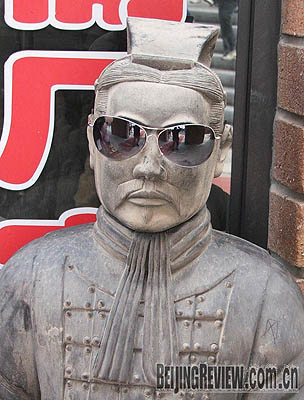|

COOL WARRIOR: Despite the attraction of the Terracotta Army, much still waits to be uncovered in Xi'an
FRANCISCO LITTLE
When foreigners make their lists of what to see and do in China, it's a tough call. With historical overload rife in the Middle Kingdom, ancient sites and treasures are virtually a dime a dozen. And then there is Xi'an in west China's Shaanxi Province.
Possessing a historical pedigree that defies description, there is much underfoot in Xi'an. Standing in the downtown Bell Tower trying to make sense of it all on a dusty evening, I tried to imagine the city in its former incarnations, a city that once competed with ancient Rome and Constantinople in the Byzantine Empire as the world's supreme metropolis.
Providing a resonant backdrop to my musings was an overenthusiastic tourist who pounded away on the large bell on the tower's top floor. Stretching out from each major point of the compass, a main road disappeared into the horizon. Four arterial routes, one tower hub--what could be more logical than creating easy access on an axis.
For all the places those four roads take visitors and the subsidiary reasons people visit Xi'an: the finger of Sakyamuni, the city wall, and the foot of Hill Lishan where Kuomintang leader Chiang Kai Shek was captured in 1936, ending 10 years of civil war, in what became known as the Xi'an Incident, we're all really here to see one thing and one thing only.
It would be an understatement to say Emperor Qinshihuang, the founding emperor of the Qin Dynasty (221 B.C.-206 B.C.), led a full life. His list of achievements included uniting the country by defeating countless states, creating a uniform currency and script and starting the construction of what became the Great Wall. Quite a CV! Yet what the eccentric emperor is best remembered for is how he prepared his journey into the next world.
They stand in honor of their departed emperor, now more than 2,000 years after his death, brick red guardians, each unique, each silent. The Terracotta Army has changed Xi'an irreversibly. Discovered by farmers in 1974, the cavernous main vault is home to more than 6,000 life-size pottery warriors, chariots and horses arranged as the main force in battle formation. Two other vast vaults, currently under excavation, make up the flank force and military headquarters. It's impressive. The UN Educational, Scientific and Cultural Organization thought so too, naming it a World Heritage Site in 1987. Today it has spawned an industry like no other and has put Xi'an firmly on every traveler's map. Warrior souvenirs are literally available everywhere in Xi'an, and are made into everything from ice creams to the male mannequins gracing designer shop windows.
As I walked over the sizable grounds around the vaults--I tried to block out the incessant blare of tour guide bullhorns and the jostle of endless crowds--and thought about what must still lie below my feet.
My own tour guide had told me that while more than 4,000 historical sites and tombs have been excavated to date around Xi'an, more than 120,000 relics remain unearthed. Cities built upon cities for over 3,000 years and through 13 dynasties meant what we are seeing here is in all probability just a sample of a much bigger picture.
When I look at Chinese tradition I find a similar situation, where individuals are given to keep a low profile, and we only get glimpses of the whole. The notion of staying among the crowd and doing nothing to be noticed goes back millennia and in a sense cleverly buries much in both the process of communication and in conveying any sign of success.
Taoist founder and influential thinker Lao Tzu advocated the early retirement of people once they had achieved success, marking a smooth transition from fame to obscurity. As he writes in Daode Jing (Tao Te Ching or Classic of the Way and Virtue), "The Tao that can be named is not the Tao." Understanding this, the insight of experiences cannot always be expressed. Much goes left unsaid.
It's a concept that gives way, in a philosophical sense, to a kind of vagueness that characterizes Chinese tradition (certainly among the middle-aged and seniors) and is epitomized by a well-known local proverb that says, "The big tree is more easily blown down by the wind." Going about one's daily affairs quietly and not attracting too much attention is probably a good way to ensure self-preservation, for whatever reason, and there are no doubt many. And it is for this reason one gets the impression that so much of Chinese culture lives under the radar. What we see is a tip of the cultural iceberg, where things are implied but never directly stated and a smile or a "maybe" is often the answer to questions. The subtleties of flowing with this way of thinking takes some time to get used to as a foreigner, where so much of our thinking is based on "yes" or "no" answers.
There will always be mystery in what we cannot see, whether it's yet to be discovered treasures or unfathomable cultural intricacies. In China there is much that remains below the surface. | 